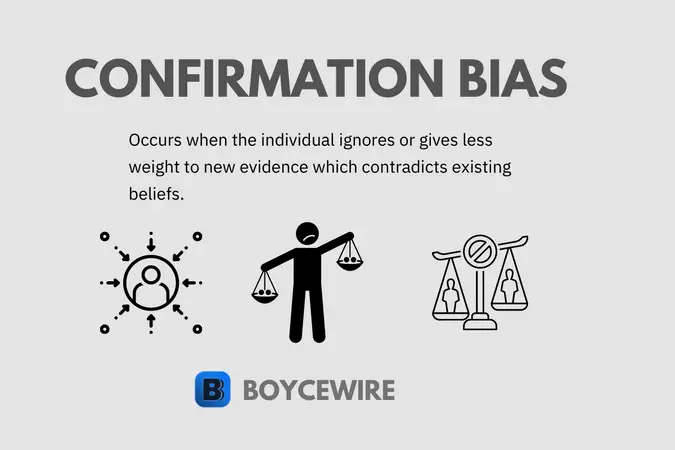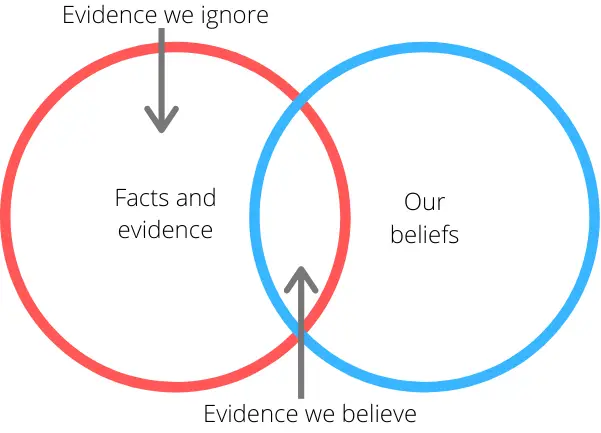Confirmation Bias: Definition and Examples

What is Confirmation Bias
Confirmation bias happens when individuals overlook information that contradicts their current beliefs and instead look for information that confirms their views. As a result, they dismiss new information that contradicts their beliefs.
The reason for this tendency is that existing information is stored in our subconscious memory, which is difficult to change. This is comparable to uploading an image on the internet, where once it’s there, it’s hard to remove.
Key Points
- Confirmation bias is where we ignore information that contradicts our existing beliefs.
- We also seek out information that re-enforces our beliefs.
- Confirmation bias is partially driven by ego. Nobody likes to be wrong after believing in something for so long.
Confirmation bias is often influenced by ego and self-esteem. It can be difficult for individuals to admit that they have been wrong about a belief they have held for a long time. For instance, they may have believed that the world is flat or that the moon is made of cheese. It can be embarrassing to admit that they were wrong all along, and this can fuel their tendency to search for information that confirms their beliefs and ignore information that contradicts them.
How it works
The brain consists of two parts, the subconscious and the conscious. The conscious part is responsible for active thinking, learning and processing new information. On the other hand, the subconscious serves as a memory hub that stores information that our brain has learned, which helps to speed up our processing time.
Activities like typing, walking, or talking require us to use our conscious brain to learn them. However, once we have learned them, they become second nature and are stored in our subconscious, making it unnecessary for us to consciously think about them. This includes remembering familiar routes, daily commutes, and habitual behaviors.
In essence, the subconscious serves as a shortcut that allows the brain to access previously learned information quickly, thereby freeing up our processing capacity to focus on other tasks.

How this creates Confirmation Bias
As we grow up, we acquire knowledge and skills through our experiences and environment. For example, we learn to walk, talk, and write, as well as develop beliefs and values shaped by our upbringing. These beliefs and values become ingrained in our subconscious and can influence our political views and opinions.
Confirmation bias can occur when we encounter information that contradicts our existing beliefs. Instead of being open-minded and considering new information, we tend to reject it in favor of what we already know. This is because our subconscious beliefs are deeply rooted and difficult to change.
Confirmation bias is particularly prevalent in politics, where individuals’ views and beliefs are often shaped by their upbringing and environment. For example, if someone grew up in a conservative household, they may hold conservative views on issues such as immigration or healthcare. When presented with information that contradicts these beliefs, they are more likely to reject it and confirm their existing views.
Overall, confirmation bias can hinder our ability to learn and grow. It is important to be aware of our biases and strive to approach new information with an open mind.
Confirmation Bias Examples
Confirmation bias occurs when individuals ignore new information that contradicts their existing beliefs. This can manifest in many ways, such as only consuming news from sources that align with their views or disregarding eyewitness accounts that conflict with their beliefs. It can also be present in religious or social media contexts.
1. Confirmation Bias in Politics
Politics is inherently divisive, and breaking people’s voting habits can be a real challenge. In the US, states are usually categorized as either ‘Red’ or ‘Blue’ depending on their political affiliation with the Republican or Democratic party, respectively. Once a state leans one way or the other, it can take years for it to change.
Most people tend to stick with their political leanings throughout their lifetime, and only a small group of ‘swing voters’ are open to new candidates. This is because of confirmation bias, which can be a powerful force.
The effects of confirmation bias can be seen in people’s media consumption habits. For example, Republican voters tend to favor Fox News, a right-leaning media company, over CNN, which is left-leaning. The opposite is true for Democrat voters, who prefer CNN over Fox News. This happens because information that conflicts with existing beliefs is often rejected in favor of information that confirms those beliefs.

Confirmation bias also affects politicians, who are often reluctant to change their positions even when presented with new evidence that challenges their beliefs. For instance, over 100 members of Congress have rejected the idea of man-made climate change, dismissing it as incompatible with their existing views.
Another area where confirmation bias comes into play in politics is in the case of rent controls. Despite the majority of economists agreeing that they are counterproductive, many left-leaning politicians still advocate for them.
2. Eyewitness Accounts
The criminal justice system is moving away from relying solely on eyewitness accounts and towards more accurate evidence such as DNA. This has led to the exoneration of many previously imprisoned individuals.
Eyewitness accounts have long been recognized as problematic. People often have difficulty remembering precise details and can be influenced by various factors, including confirmation bias.
For example, imagine a witness who sees a homicide and identifies the perpetrator as their sibling. The witness may be unable to believe that their sibling is capable of such a crime, and so they reject the idea. Instead of accepting the new information, they cling to their existing belief and confirmation bias takes hold.
3. Religion
Believers in a religion tend to have a bias towards their existing beliefs, where anything unexpected that happens is considered a ‘miracle’, and any disaster is seen as a ‘test of faith’. This confirmation bias seeks to uphold their pre-existing beliefs.
On the other hand, those who do not have a religion tend to view miracles as rare events that can happen naturally, and therefore do not provide evidence of a higher power. In the same way, large-scale disasters such as tsunamis and hurricanes that cause massive destruction and loss of life are used to justify the idea that a god cannot exist.
Both believers and non-believers tend to interpret events in a way that confirms their existing beliefs, whether the events are positive or negative.
4. Social Media
Social media has become a breeding ground for the spread of fake information. People tend to share news articles or information that reinforces their pre-existing beliefs. Often, eye-catching headlines are used to attract attention, offering unsupported claims.
There are news articles that claim to present “facts,” but are instead presenting a biased perspective that aligns with the reader’s own beliefs. As a result, unsupported claims that do not have any evidence to support them are perceived as “factual” because they align with pre-existing beliefs.
This information is then spread across social media platforms, gaining more and more traction as it confirms the beliefs of millions of people.
How to Avoid Confirmation Bias
Admitting the existence of confirmation bias is the first step towards avoiding it. Awareness of when it occurs is necessary to take steps to address it.
To avoid confirmation bias, it is important to consider other points of view and listen to the other side of the argument with an open mind. It may be uncomfortable, but surrounding ourselves with people whose opinions differ from ours is essential to challenge our existing ideas. It is also important to acknowledge that we do not know everything, and new information can provide us with new knowledge to better understand the world.
The best way to avoid confirmation bias is to understand our limitations as humans. We only have access to a limited amount of information at any given time, so it is logical that our views may change over time. Being open to change and different ideas is key to avoiding confirmation bias.
This can be summarized below:
- Admit the existence of confirmation bias.
- Look at other points of view and listen to the other side of the argument with an open mind.
- Surround ourselves with people whose opinions differ from ourselves to challenge existing ideas.
- Acknowledge that we do not know everything and that new information can help us understand the world.
- Understand that our views should and could change over time due to limited information.
- Be open to change and different ideas to avoid confirmation bias.
Confirmation Bias FAQs
Confirmation bias is where people ignore information that contradicts their existing beliefs. You can often identify it when people are unwilling to listen to new information or use that information in a way that confirms their belief.
A heavy smoker comes across a study that states smoking causes lung cancer. Yet they reject it stating that the study is flawed. However, they later come across another study stating that smoking can cure lung cancer. They state that this study is accurate, thereby aligning with their belief that smoking doesn’t cause harm.
Confirmation bias makes us think inside an echo chamber, thereby restricting our ability to think outside the box. It makes it difficult for us to comprehend ideas or beliefs that are outside of our own. Therefore, it can reduce the amount of innovation and progress we make as a society.
On an individual level, it can stall career progress if we cannot adapt to new scenarios. By challenging our existing thoughts and beliefs, we are able to progress, grow our knowledge, and become more rounded individuals.
The best way to overcome confirmation bias is to obtain an open mind. By actively seeking out reasons why you may be wrong instead of why you are right, you can obtain a better and well rounded opinion.
About Paul
Paul Boyce is an economics editor with over 10 years experience in the industry. Currently working as a consultant within the financial services sector, Paul is the CEO and chief editor of BoyceWire. He has written publications for FEE, the Mises Institute, and many others.

Related Topics
Further Reading
 Marginal Benefit Definition and Examples - Marginal benefit is the extra benefit or utility that an individual receives from consuming or producing one additional unit of…
Marginal Benefit Definition and Examples - Marginal benefit is the extra benefit or utility that an individual receives from consuming or producing one additional unit of…  Cottage Industry - Cottage industry refers to small-scale, often home-based, businesses that involve manual labor and traditional production methods to create handmade or…
Cottage Industry - Cottage industry refers to small-scale, often home-based, businesses that involve manual labor and traditional production methods to create handmade or…  Accrued Expenses - Accrued expenses refer to financial obligations incurred by a business for goods or services received but not yet paid for.
Accrued Expenses - Accrued expenses refer to financial obligations incurred by a business for goods or services received but not yet paid for. 